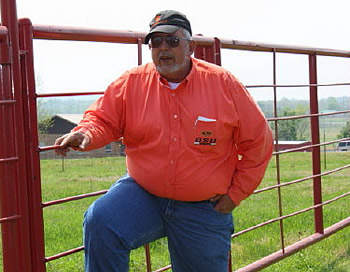
Agricultural News
Dave Sparks Outlines Beef Quality Assurance for Cow Operators
Tue, 26 Nov 2013 17:01:05 CST

Dave Sparks, DVM, Oklahoma State University Area Extension Veterinarian writes in the latest Cow-Calf Newsletter:
Much has been said about Beef Quality Assurance in recent years, but how many of us really know what it is and why it is important to all beef producers? Simply put, BQA is the effort to instruct beef producers, and their workers, as to ways that they can produce a high quality and wholesome product that keeps the consumer coming back for more.
While great strides have been made with fed cattle, cow operators have a ways to go. In feedlots a few people are handling large numbers of cattle, and feedback from the processor is fairly simple. In cow country, many more people are handling smaller numbers of cattle, and the feedback, while real, is not so obvious. Injection site lesions in the sirloin are one measure of the care with which cattle are processed and medicated. From 1995 to 1999 the feedlot industry reduced these lesions from 12% of fed carcasses to less than 2%. At the end of this time period, however, over 40% of all cow and bull carcasses had lesions in the sirloin. Too often cow operators see the cow as a calf production unit rather than a part of the food chain. The fact is, about ¼ of the beef consumed in our country comes from cull cows and bulls and it is not all hamburger. Today, the better cuts such as the round, sirloin, loin, and rib-eye allow the packers to pay better cow prices than we have seen in years past. Cull cows represent about ¼ of the gross income for most cow operators. If we, as an industry, could reduce the annual carcass losses due to bruising, injection lesions, excess fat trim, and condemnation due to drug residues, what would be your part of the extra ½ billion dollars on the table? Cow buyers are aware of what this waste costs, and they know which herds, areas, and sales most of the problems come from. When your culls come through the ring you need as many hands in the air as possible.
Proper techniques when handling and processing cattle can go a long way. Use the smallest needle that will do the job and change it at least every 10 head. Dull needles cause more lesions, and a needle that fatigues and breaks off is a serious problem. While injection site lesions are trimmed away when found, they make the whole cut of meat tougher due to extra connective tissue deposited in the muscle. Be sure to give all injections in front of the shoulder, and when you have a choice, give injections subcutaneously. Reduce bruising by eliminating overcrowding and make sure loading facilities are safe and cattle flow through them easily. Market cull cows before lameness and eye problems get severe, or barren cows get overly fat.
Proper drug and vaccine usage can be summed up with 5 words, "Read the label," and "Keep records." Drug residue problems result when dosage, course of treatment, or route of administration are not according to the label, or specified withdrawal time before slaughter is not adhered to. According to law, all violations are the responsibility of the producer, so if you have a problem not only are the future prices you receive affected, but you will be subject to possible fines and/or quarantine. If you do have a violation and you can produce proper treatment records, officials are likely to work with you to help identify and solve the problem. Without records, they may well resort to sterner measures.
As Americans we have the safest and most wholesome meat in the world, but we need to constantly work to keep it that way. Beef is still "What's for Dinner" today, but we need to make sure it's on the menu tomorrow too.
WebReadyTM Powered by WireReady® NSI
Top Agricultural News
More Headlines...



















